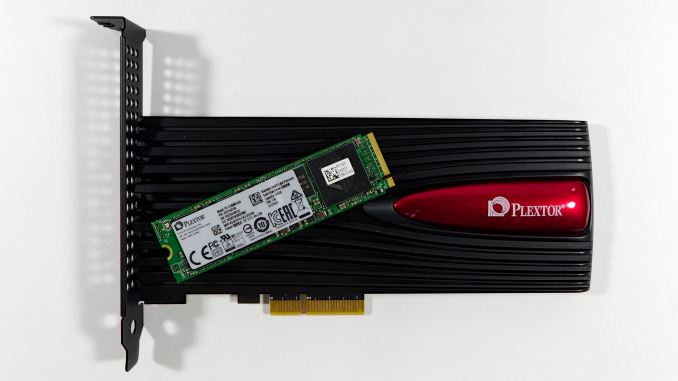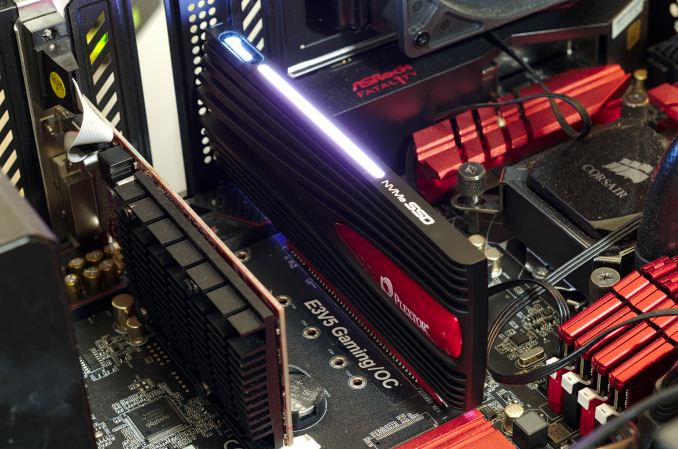The Plextor M9Pe NVMe SSD Review: Teaching An Old Chip New Tricks
by Billy Tallis on May 24, 2018 1:00 PM EST
The M9Pe is the new flagship SSD from Plextor, and its first NVMe SSD to use 3D NAND flash memory. The M9Pe is the successor to both the M8Pe, which used Toshiba 15nm MLC, and the M8Se, which used Toshiba 15nm planar TLC. As with most SSD product lines, as a general industry wide implementation, MLC NAND is being abandoned in the transition to 64-layer 3D NAND. The M9Pe was officially launched at the beginning of this year, but the M9Pe didn't hit the shelves until March, and supplies are still inconsistent.
Plextor in the SSD Market
Plextor is the retail SSD brand of Lite-On, one of the larger suppliers of SSDs for OEMs. Lite-On doesn't manufacture their own NAND flash memory or SSD controllers, so their primary means of product differentiation is through writing their own SSD controller firmware. This often gives them an edge against companies that simply re-brand reference designs from the controller vendors, but as the biggest players in the SSD market are increasingly vertically integrated it is getting harder for Plextor to compete. The Plextor-branded retail NVMe SSDs also offer the cosmetic distinction of optional heatspreaders and add-in card adapters with heatsinks and LEDs. Aside from those cosmetic touches, the M9Pe is essentially the same as the Lite-On CA3 client SSD we reported on previously.
Using Toshiba NAND and Marvell Controllers
Like most Plextor SSDs, the M9Pe uses Toshiba NAND flash memory. This time it is Toshiba's 64-layer third-generation 3D TLC NAND. This is Toshiba's first mainstream, mass-produced 3D NAND, branded by Toshiba as BiCS 3. The controller in the M9Pe is the same Marvell 88SS1093 "Eldora" used in the preceding M8Pe and M8Se SSDs, so the M9Pe derives almost all of its improvements from the upgraded NAND. Plextor has managed to implement NVMe 1.3 features for the M9Pe despite using an older controller that was originally designed to target the NVMe 1.1 specification.
As with other NVMe SSDs from this generation, the large 256Gbit or 512Gbit capacity of each NAND flash die hurts performance of the smallest drive capacities. The 128GB option is gone from this generation because that would only use half of the controller's eight NAND channels. The 256GB M9Pe still has distinctly lower performance specifications than the larger models, especially for write speeds. Overall, performance specs are a bit below other current high-end NVMe SSDs like the Samsung 970 EVO and Western Digital WD Black.
The five year warranty period and ~0.3 drive writes per day endurance rating are typical for this product segment.
| Plextor M9Pe Series Specifications Comparison | |||||
| 256 GB | 512 GB | 1 TB | |||
| Form Factor | M9PeY | Half-height half-length PCIe add-in card (HHHL) | |||
| M9PeG | M.2 2280 with heatspreader | ||||
| M9PeGN | M.2 2280 without heatspreader | ||||
| Controller | Marvell 88SS1093 "Eldora" | ||||
| Interface | NVMe 1.3 PCIe 3.0 x4 | ||||
| DRAM | 512MB LPDDR3 | 1024MB LPDDR3 | |||
| NAND | Toshiba 64L BiCS3 3D TLC | ||||
| Sequential Read | 3000 MB/s | 3200 MB/s | 3200 MB/s | ||
| Sequential Write | 1000 MB/s | 2000 MB/s | 2100 MB/s | ||
| 4KB Random Read (QD32) | 180k IOPS | 340k IOPS | 400k IOPS | ||
| 4KB Random Write (QD32) | 160k IOPS | 280k IOPS | 300k IOPS | ||
| Endurance | 160 TBW 0.3 DWPD |
320 TBW 0.3 DWPD |
640 TBW 0.3 DWPD |
||
| Warranty | 5 years | ||||
| Current Price |
M.2 | $119.99 (47¢/GB) | $209.19 (41¢/GB) | $408.26 (40¢/GB) | |
| M.2 with heatspreader | $123.62 (48¢/GB) | $219.99 (43¢/GB) | $441.87 (43¢/GB) | ||
| Add-in card | $160.72 (63¢/GB) | $245.02 (48¢/GB) | Unavailable | ||
The M9Pe is SSD is packaged in three different variants. The cheapest M9PeGN is the bare M.2 SSD. The M9PeG adds a heatspreader to the drive that should help a bit with thermal throttling during sustained workloads but may be physically too large to fit in some notebook systems. The M9PeY mounts the M.2 module on a PCIe x4 half-height half-length adapter card with a large heatsink and a row of RGB LEDs. The previous generation M8Pe and M8Se featured red and blue LEDs respectively, so RGB is the obvious way to make the M9PeY even gaudier. The RGB LEDs cannot be controller by the user and instead are managed by the same ITE 8259FN chip we've seen on several motherboards that also feature RGB LEDs. Aside from the lighting, the heatsink of the M9PeY is almost identical to the M8SeY, with a blue plastic insert swapped for red.
Since it first hit the shelves, prices on the M9Pe have come down to roughly match other top SSDs when comparing against the M9PeGN variant that lacks a heatsink. The versions with extra cooling carry a substantial premium. Newegg is the only major online retailer selling the M9Pe, and they're not currently listing the 1TB M9PeY add-in card model.
Our review samples are the 512GB M9PeGN (M.2) and the 1TB M9PeY (AIC), but we've also swapped the drives in the adapter card to present results for both capacities running as standalone M.2 drives and in the adapter with the heatsink and LEDs.
Competition for the M9Pe
Most of the competition for the M9Pe uses substantially different hardware. The second-generation Western Digital WD Black uses the same BiCS3 3D TLC NAND as the M9Pe but features Western Digital's new in-house controller. The M9Pe shows us what the new WD Black would have been like if WD's new controller hadn't been ready and if they had stuck with the Marvell controller for another generation. The WD Black and the Samsung 970 EVO showcase the strengths of a vertically integrated strategy with the NAND, SSD controller, firmware and drive all designed by the same company.
A little lower on the price scale are several competitors based around Silicon Motion's second generation SM2262 controller, a huge improvement over their earlier SM2260 controller. Intel uses the SM2262 in their own 760p SSD, and cheaper drives based on the SM2262 reference design are being sold by ADATA and HP. These drives offer performance close enough to the top SSDs that it's hard to pass up the savings.
For comparison against other market segments, this review also includes results from the ultra-premium Intel Optane SSD 900P and Samsung 960 PRO, the entry-level NVMe MyDigitalSSD SBX, and the mainstream SATA Crucial MX500.
This is our last SSD review using our 2017 SSD test suite. Future reviews will feature benchmark results from a testbed with Meltdown and Spectre patches and microcode updates current as of this month, and a few other tweaks to the test procedure. The Windows 10 version will still be 1709, because Microsoft has not yet fixed all the new bugs introduced in the NVMe driver in Windows 10 version 1803.
| AnandTech 2017/2018 Consumer SSD Testbed | |
| CPU | Intel Xeon E3 1240 v5 |
| Motherboard | ASRock Fatal1ty E3V5 Performance Gaming/OC |
| Chipset | Intel C232 |
| Memory | 4x 8GB G.SKILL Ripjaws DDR4-2400 CL15 |
| Graphics | AMD Radeon HD 5450, 1920x1200@60Hz |
| Software | Windows 10 x64, version 1709 |
| Linux kernel version 4.14, fio version 3.1 | |
- Thanks to Intel for the Xeon E3 1240 v5 CPU
- Thanks to ASRock for the E3V5 Performance Gaming/OC
- Thanks to G.SKILL for the Ripjaws DDR4-2400 RAM
- Thanks to Corsair for the RM750 power supply, Carbide 200R case, and Hydro H60 CPU cooler
- Thanks to Quarch for the XLC Programmable Power Module and accessories
- Thanks to StarTech for providing a RK2236BKF 22U rack cabinet.

















15 Comments
View All Comments
Yuriman - Thursday, May 24, 2018 - link
Looks like that heatspreader does it a lot of good.peevee - Tuesday, May 29, 2018 - link
But the price of it? I understand it for $4 on 256GB model. But why the same thing is closer to $40 on 1T?romrunning - Thursday, May 24, 2018 - link
Regarding the testing platform: "The Windows 10 version will still be 1709, because Microsoft has not yet fixed all the new bugs introduced in the NVMe driver in Windows 10 version 1803."If you're referring to the issues with Intel 600p drives in the April Update (version 1803), Microsoft released a new patch (KB4100403) that "Addresses an issue with power regression on systems with NVMe devices from certain vendors."
So it sounds like you should be able to update Windows to 1803 as long as you include that patch.
Billy Tallis - Thursday, May 24, 2018 - link
That's not the only problem that's been reported with 1803's NVMe driver. I don't trust that they've even found all the new bugs yet, let alone patched them all. And I actually started running the new tests almost a month ago, to try to minimize the interruption to our review schedule.Drazick - Thursday, May 24, 2018 - link
Are you sure it is Microsoft's issue and not the firmware of those drives?Billy Tallis - Thursday, May 24, 2018 - link
In the absence of a proper changelog from Microsoft, I assume the new issues are mostly their fault. At the very least, they're responsible for upsetting whatever fragile balance of bugs the SSD manufacturers have achieved by testing against previous versions of Windows 10. I want to freeze my testbed software configuration for at least a year, and there's sufficient reason to consider 1803 as still being essentially beta-quality and thus a bad choice for the 2018 SSD test suite.GeorgeH - Thursday, May 24, 2018 - link
FWIW that's very reasonable. It's utterly foolish to update to any Windows 10 version until at least 6 months after release (unless your time is worthless and you'd like to do free QA for Microsoft, of course).lmcd - Thursday, May 24, 2018 - link
Not even close to true. In fact, it's because I value my time that I upgraded to 1803 immediately. 1803 adds the "Windows Hypervisor Platform" to its features, which (as a primary effect) allows Docker for Windows and a buggy-but-usable Xamarin variant of AVD to run side-by-side (along with other Hyper-V images). It's possible we even see VirtualBox run on this excellent feature, though I don't know if it's on their roadmap yet.smilingcrow - Friday, May 25, 2018 - link
Which is an irrelevant feature for most home users so your post is myopic.Death666Angel - Friday, May 25, 2018 - link
If you are running normal consumer grade hardware, I don't think that is the case.